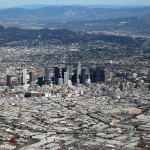 In Cabinet spring 2013, Geoff Manaugh investigates the relationship between geography and the crimes that geography affords.
In Cabinet spring 2013, Geoff Manaugh investigates the relationship between geography and the crimes that geography affords.
In the 1990s, Los Angeles held the dubious title of “bank robbery capital of the world.” At its height, the city’s bank crime rate hit the incredible frequency of one bank robbed every forty-five minutes of every working day. [An FBI Special Agent once joked] the agency even developed its own typology of banks in the region, most notably the “stop and rob”: a bank, located at the bottom of both an exit ramp and an on-ramp of one of Southern California’s many freeways, that could be robbed as quickly and as casually as you might pull off the highway for gas.
That greater LA covers 33 thousand square miles and is the largest in the US is a geographic statistic that might skew the number of robberies per hour, but is ignored in the story.
Still, Manaugh walks us through a handful of examples before settling into one particularly juicy unsolved series of heists, about which he concludes:
The insights offered by slicing through the complex topology of the built environment can be extraordinary, despite the fact that, or perhaps precisely because, acting upon these insights is illegal. They are, we might joke, crimes against space.
[…]
Policing the city, in that moment, becomes as much about preventing new spatial connections — new and illicit diagonals leading from one point to another — from emerging as it is about watching its surfaces for crimes yet to occur.
Photo from Wikimedia.